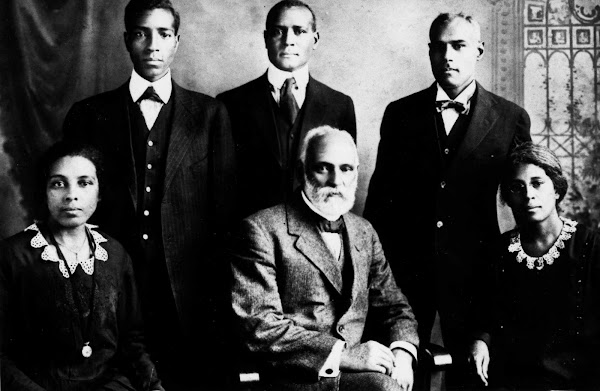Hundreds of documents comprise Edwin and Elise Harleston's letters. The correspondence telegrams, letters, postcards and notes between the couple, as well as from family members, friends, business associates and clients.
The bulk of those appearing on this blog were written by Tantie and Uncle Teddy between 1913 and 1930, during their courtship and marriage. I also plan to include letters from the early 1900s, before they met -- during his years as an undergraduate at Atlanta University and as an art student in Boston.
In the early years of their courtship, Tantie and Uncle Teddy's correspondence is sparse, but by 1919, when the couple began making plans for their future – plans that required her to study photography in New York – their written communication is more abundant. I excluded letters that I decided were redundant or that would not interest a general audience.
Most of the letters were handwritten. The few that were typewritten contained spacing errors that I have silently corrected. Generally, I transcribed the letters verbatim, using ellipses when deleting words and using brackets to note added verbiage.
I corrected errors that were obviously unintentional, such as repeated words, and some misspellings that I thought distracting. Idiosyncratic misspellings (“thot” instead of “thought”) were retained, as were abbreviations of city names (“Chaston” for “Charleston,” for example, and “Phila” for “Philadelphia”) and shorthand addresses (“121" meaning the Harleston Funeral Home or its third-floor apartments at 121 Calhoun Street; “97" meaning the Forrest family home at 97 Morris Street).
Blacked-out passages generally were not noted, unless the letter writer mentioned the erasure. In that case, I noted in brackets that a passage had been blacked out.
Edwin Harleston is referred to Teddy, Ted or Tedwin, among other nicknames. Elise Harleston appears in the letters as Lise, Lisa, Liza and other iterations of Elise.
The vast majority of the letters were written on plain stationery. If deemed significant, the use of letterhead stationery is mentioned in notes.
Over the years, many of the letters were removed from their envelopes, making it difficult to determine the dates of undated correspondence. In those cases, I made an educated guess and inserted the letter where it appears to belong.
The bulk of those appearing on this blog were written by Tantie and Uncle Teddy between 1913 and 1930, during their courtship and marriage. I also plan to include letters from the early 1900s, before they met -- during his years as an undergraduate at Atlanta University and as an art student in Boston.
In the early years of their courtship, Tantie and Uncle Teddy's correspondence is sparse, but by 1919, when the couple began making plans for their future – plans that required her to study photography in New York – their written communication is more abundant. I excluded letters that I decided were redundant or that would not interest a general audience.
Most of the letters were handwritten. The few that were typewritten contained spacing errors that I have silently corrected. Generally, I transcribed the letters verbatim, using ellipses when deleting words and using brackets to note added verbiage.
I corrected errors that were obviously unintentional, such as repeated words, and some misspellings that I thought distracting. Idiosyncratic misspellings (“thot” instead of “thought”) were retained, as were abbreviations of city names (“Chaston” for “Charleston,” for example, and “Phila” for “Philadelphia”) and shorthand addresses (“121" meaning the Harleston Funeral Home or its third-floor apartments at 121 Calhoun Street; “97" meaning the Forrest family home at 97 Morris Street).
Blacked-out passages generally were not noted, unless the letter writer mentioned the erasure. In that case, I noted in brackets that a passage had been blacked out.
Edwin Harleston is referred to Teddy, Ted or Tedwin, among other nicknames. Elise Harleston appears in the letters as Lise, Lisa, Liza and other iterations of Elise.
The vast majority of the letters were written on plain stationery. If deemed significant, the use of letterhead stationery is mentioned in notes.
Over the years, many of the letters were removed from their envelopes, making it difficult to determine the dates of undated correspondence. In those cases, I made an educated guess and inserted the letter where it appears to belong.







No comments:
Post a Comment